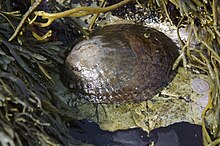Lottia gigantea
| Lottia gigantea | |
|---|---|
 |
|
| Lottia gigantea | |
 |
|
| Lottia gigantea | |
| Scientific classification | |
| Kingdom: | Animalia |
| Phylum: | Mollusca |
| Class: | Gastropoda |
| (unranked): | clade Patellogastropoda |
| Superfamily: | Lottioidea |
| Family: | Lottiidae |
| Genus: | Lottia |
| Species: | L. gigantea |
| Binomial name | |
|
Lottia gigantea G. B. Sowerby I, 1834 |
|
Lottia gigantea, common name the owl limpet, giant owl limpet or solitary giant owl limpet, is a species of sea snail, a true limpet, a marine gastropod mollusc in the family Lottiidae. Its genome has been sequenced at the Joint Genome Institute.
The owl limpet is found on the Pacific coast of North America from northern California to southern Baja California.
The owl limpet grows to a length of up to nine centimetres. The often much eroded shell has an elongated low cone shape with the apex close to one end. The anterior slope is concave. The general colour is brownish grey with pale markings and the foot is pale grey with a yellow or orange sole. There is also a small form that lives on the shells of mussels. It is even more elongated, up to twenty-five millimetres long, and dark blue with concentric growth rings. Its foot and head are entirely black.
Round the edge of the foot the owl limpet has a distinctive pallial gill system which uses currents caused by the beating of cilia to circulate water over the gills when submerged.
It is most abundant in California and favours vertical rock faces in wave-swept areas in the upper littoral zone. It grows slowly and may live for up to twenty years. It browses on microalgae growing on rock surfaces.
The owl limpet is a territorial species and some individuals return to the same specific homesite every time the tide goes out. The limpet's contours grow to fit the rock surface tightly.
Owl limpets are protandric hermaphrodites. They spend about two years as juveniles before starting their reproductive lives as male limpets. If they survive long enough, some of them later transform into females. Spawning takes place once a year in the winter. The larvae are pelagic and form part of the zooplankton. They may be transported large distances by currents before settling on suitable rock surfaces.
...
Wikipedia
